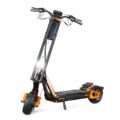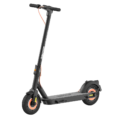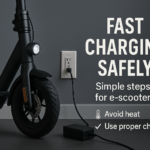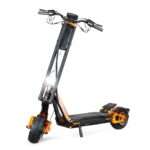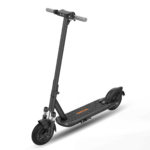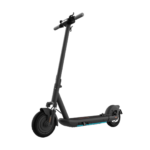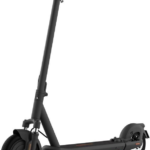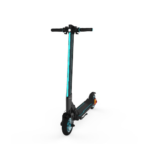- Home
- Scooters
- Electric Scooters
- INMOTION Air Pro
INMOTION Air Pro
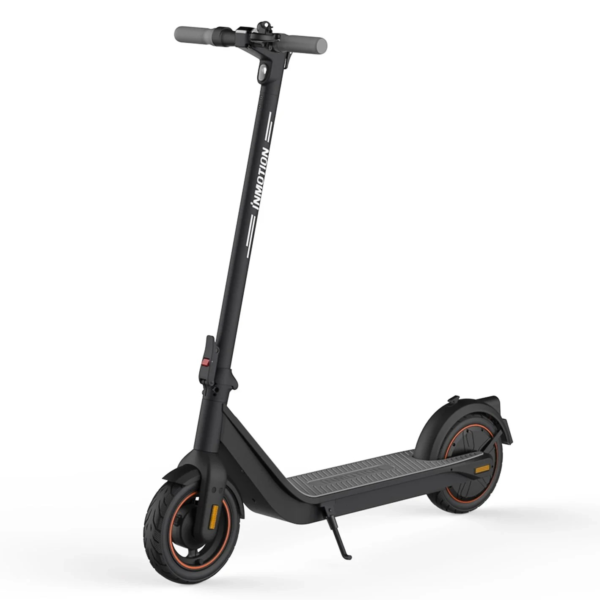

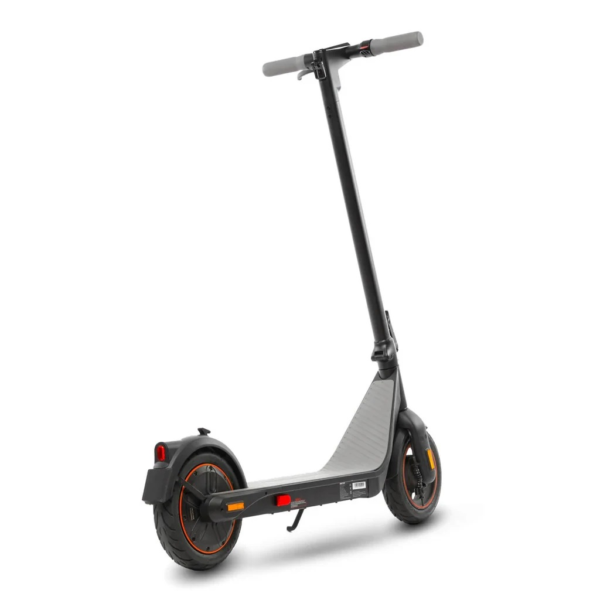
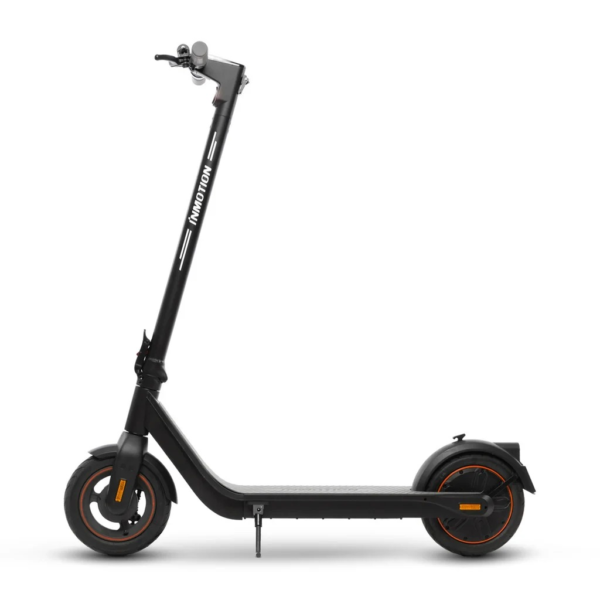
- Battery Range: 30 miles (48 km)
- Top Speed: 22 mph (35 km/h)
- Motor Power: 400 W
- Weight Capacity: 264 lb (120 kg)
- Charging Time: ~8.5 h
- Scooter Weight: 39.0 lb (17.7 kg)
PROS
- 22 mph (35 km/h) top speed
- 30 miles (48 km) range
- Rear foam-filled + front pneumatic tires
- Dual braking: drum + regen
- IP55 water resistance
- Balanced 39 lb (17.7 kg) weight
CONS
- No suspension
- Heavier than Air
- Single-motor hill power modest
Key Takeaways
- The INMOTION Air Pro is a lightweight, rear-drive commuter scooter that offers a smooth ride and practical features for city use.
- It boasts a top speed of 22 mph and a range of approximately 30 miles, making it suitable for daily commutes.
- With its solid build, IP55 rating, and easy folding mechanism, the scooter excels in portability and daily usability.
- Key features include regenerative braking, cruise control, a central display, and compatibility with the INMOTION app for added convenience.
- Ideal for urban riders, students, and commuters, the Air Pro is not designed for off-road use or high-speed enthusiasts.
Table of contents
- What Is the INMOTION Air Pro?
- How the INMOTION Air Pro Works
- Key Specifications
- Design & Build Quality
- Performance Fundamentals
- Battery, Range & Efficiency
- Ride Quality & Comfort
- Braking & Safety Features
- Portability & Daily Usability
- Maintenance & Care
- Weather & Seasonal Considerations
- INMOTION Air Pro vs Alternatives
- Who the INMOTION Air Pro Is (and Isn’t) For
- FAQs
- Glossary
The INMOTION Air Pro is a light, no-drama commuter scooter built for real city rides. It mixes a rear-drive motor, a solid battery, and a fast fold. So it fits new riders and practical commuters who want steady speed, easy handling, and low upkeep. This overview follows the official specifications and keeps the tone simple. If you want to compare within the brand, take a quick look at the INMOTION S1F.
What Is the INMOTION Air Pro?
The Air Pro lives in the compact commuter class. It uses a rear 400 W rated motor with 750 W peak, so it moves off the line cleanly and holds pace on flat streets. The top speed hits 22 mph (35 km/h) in the fastest mode. The rated range is 30 miles (48 km) in steady conditions. The deck supports up to 264 lb (120 kg), and the scooter itself weighs about 39 lb (17.7 kg). So most adults can carry it up a short flight without too much effort. You get a 10-inch pneumatic front tire for comfort and grip, plus a 10-inch foam-filled rear tire that cuts flats. Braking pairs a rear electronic system with a front drum. The body carries an IP55 rating for dust and spray. The cockpit stays tidy. You get a central display, a right-hand throttle, and a single brake lever.
How the INMOTION Air Pro Works
Think of the scooter as four parts that chat with each other. The controller is the brain and sends current to the motor. The motor sits in the rear hub and turns that current into motion. The battery stores energy for the trip. And the throttle tells the controller when you want more or less. The brake lever sends a different message. slow me down and grab some energy back.
The throttle comes in smooth, so starts feel calm and predictable. The controller avoids big surges that would tip weight forward. Rear-wheel drive keeps traction when you roll over damp patches or start up a hill. When you pull the lever, the scooter applies regenerative braking first. Then it blends in the front drum for stronger stops. That order keeps the chassis steady and helps avoid front-wheel slips on slick paint. The display shows speed, battery bars, mode, lights, cruise status, and basic error icons. Cruise control clicks on after you hold a steady speed for a few seconds, and it cancels as soon as you touch the brake or throttle.
Key Specifications
Below is a simple summary of the core specs. Values are US-first with metric in parentheses.
General
| Item | Value |
|---|---|
| Model | Air Pro (C1 Pro) |
| Max rider weight | 264.6 lb (120 kg) |
| Net weight | ~39.0 lb (17.7 kg) |
| Operating temp | −14 °F to 104 °F (−10 °C to +40 °C) |
| Storage temp | −4 °F to 122 °F (−20 °C to +50 °C) |
Performance & Power
| Item | Value |
|---|---|
| Rated motor power | 400 W (rear hub) |
| Peak motor power | 750 W |
| Top speed | 22 mph (35 km/h) |
| Max slope | ~20 % |
| Riding modes | D (Drive), S (Sports), Pedestrian assist |
Battery, Charging & Electrical
| Item | Value |
|---|---|
| Battery voltage (nominal/max) | 36.5 V / 42 V |
| Battery capacity | 438 Wh (36 V, 12 Ah class) |
| Cells | 21700-type lithium |
| Typical range | ~30 miles (48 km) under steady conditions |
| Charge time | ~8.5 hours with 42 V, 2 A charger |
| BMS protections | Overheat, short-circuit, over-current, over-charge |
Build & Dimensions
| Item | Value |
|---|---|
| Unfolded size (L×W×H) | 44.3 × 17.5 × 47.2 in (1125 × 445 × 1200 mm) |
| Folded size (L×W×H) | 44.3 × 17.5 × 21.6 in (1125 × 445 × 550 mm) |
| Frame | Aluminum alloy |
| Tires | 10-in front pneumatic, 10-in rear foam-filled “tubeless-style” |
Safety & Control
| Item | Value |
|---|---|
| Brakes | Rear electronic regen + front drum |
| Headlight | ~2.0 W LED |
| Tail light | ~0.8 W LED with brake light |
| IP rating (body) | IP55 |
| Reflectors | Front and rear reflectors fitted |
Features & Extras
| Item | Value |
|---|---|
| Cruise control | Yes. engages at steady speed. cancels with brake or throttle |
| Display | Central LED speedometer with mode and battery bars |
| App | INMOTION app for activation, status, and settings |
| Hidden wiring | Stem-integrated routing for a clean cockpit |
Warranty & Compliance
| Item | Value |
|---|---|
| Typical warranty | 12-month scooter coverage. region rules apply |
| Safety standards | UL-2272 certified for model family |
| Battery transport | UN/DOT 38.3 compliant |
| Radio compliance | FCC Part 15 (USA). model FCC ID: 2ADUSC1PRO |
Design & Build Quality
INMOTION keeps the shape clean, and that really helps on a daily ride. Cables run inside the stem, so nothing snags when you fold or carry. The deck has good length for a natural stance. You can stand with feet offset and keep your knees relaxed. The rubber footpad grips in wet shoes and wipes clean with a towel. Fit and finish feel tight at the hinge and at the stem crown. The latch snaps shut with a firm click. Then you can check for play by lifting the front wheel a few inches. The front fender gives fair coverage, and the tail light sits high for better visibility. The drum brake hides in the front hub, so grit does not bother it much. Plus the rear foam-filled tire shrugs off glass and thorns, which saves time on the side of the road.
Performance Fundamentals
Give it a tiny push. roll. then add throttle. The pull is smooth, not jumpy. Some budget scooters jolt right as you start, and that can throw you off. The Air Pro feeds current in a gentle curve, so launches feel controlled. Drive mode keeps things mellow on shared paths. Sports mode opens the taps, and the controller holds speed with a steady hum. The chassis tracks straight at cruise. The 10-inch tires help, and rear drive keeps the back planted over seams and patched asphalt. On short grades around 7–10 %, the scooter slows yet keeps moving if you start with a little roll. A 165 lb rider can top a city overpass without drama if they stay centered. The top end works for bike lanes and short urban hops. You will not chase big performance models, and that is fine for daily use.
Battery, Range & Efficiency
Range numbers can feel fuzzy. The Air Pro lists about 30 miles (48 km) with a 165 lb (75 kg) rider on smooth pavement at a steady pace. That is a fair baseline for planning. Cold mornings, hills, and rough surfaces cut that number. Warm days, smooth paths, and lighter riders can stretch it. Tire pressure matters a lot. The front tire lists 50 PSI max. Keep it near the high forties for low rolling drag with decent give. The pack uses 21700 cells and a protected BMS, so you do not need to baby it. Charge after rides that drop the battery to two bars. Do not store it empty. If you park the scooter for a few weeks, leave it near four bars in a cool, dry spot. The 42 V, 2 A charger fills an empty pack in about 8.5 hours. So overnight charging fits most routines, and a two-hour top-up adds helpful miles before a longer errand.
Ride Quality & Comfort
Most of the comfort comes from tire volume and calm steering. The front pneumatic tire softens the sharp stuff like expansion joints and brick seams. Your knees and ankles do the rest. The rear foam-filled tire keeps its shape under load and cannot pinch-flat, which is a nice perk. The deck sits low, so your center of gravity rides close to the axles. The scooter turns with small bar inputs and light hip pressure. Stem flex stays modest at cruise. You can feel a little spring if you rock the bar with the front brake held. That is normal for this weight class. The grips feel firm, and the bell sits where your left thumb expects it. The display stays readable in sun, and you can switch mph and km/h in the settings.
Braking & Safety Features
Braking is a bright spot for a compact scooter. The system uses regenerative braking on the rear wheel first, then blends in the front drum as you squeeze harder. That order keeps weight transfer smooth and the scooter settled. Bite firms up after about half-lever pull, and the scooter holds a straight line if you look ahead and stay tall. The headlight throws a clean beam, and the tail light brightens when you brake. Reflectors front and rear help at dusk. The IP55 rating means it resists dust and water spray from any direction. The app handles basics like activation, units, and quick checks. Cruise control helps on long bike-path sections. It turns on after you hold a steady speed and turns off as soon as you touch the brake or throttle.
Portability & Daily Usability
Folding is quick. Power off. press the locking button. pull the folding ring. then hook the stem to the rear clip. The folded size is 44.3 × 17.5 × 21.6 in, so it fits behind a desk or in a small hallway. The 39 lb weight balances near the front wheel. You can carry it by the stem in one hand with the deck at your side. Short stairs are fine. For a car trunk, lay it flat with the stem toward the center so the throttle and display stay safe. Store it indoors when possible, and use a tough lock on the frame for short stops.
Maintenance & Care
A simple routine keeps the scooter feeling fresh. Before each ride, check the latch and the brake feel. Every week, check tire pressure near 50 PSI and spin both wheels to listen for rubbing. Every month, check fasteners at the stem clamp and around the brake hardware. Wipe the deck and display with a damp cloth. Avoid pressure washers. Update the app when a new version appears, and keep the battery near two to four bars when stored. Replace the front tube if a big pothole causes repeated slow leaks. The rear foam-filled tire needs little attention, which is the point.
Weather & Seasonal Considerations
The scooter carries IP55, yet common sense still wins when it is wet. Painted lines and manhole covers get slick right after a shower, and braking distances grow. So turn on the headlight anytime you ride near sunset, and wear something reflective for cross-traffic. Cold weather cuts range. Plan an extra charge stop or ride a little slower on freezing mornings. Heat helps range a bit, but it can raise tire pressure, so check it before a long trip. Store the scooter in the shade on hot days. Avoid heavy rain and standing water. That protects bearings, electronics, and your footing.
INMOTION Air Pro vs Alternatives
Commuter scooters fall into three buckets. The light last-mile group sits under 30 lb and trades range for easy carrying. The Air Pro beats those on speed, hill hold, and stopping distance. The mid-range group sits between 35 and 50 lb and targets 18–30 miles of real travel per charge. The INMOTION Air Pro lands here with a balanced mix of speed, range, and simple care. The heavy performance group hits higher speeds and big range but weighs 60 lb or more. Daily carrying gets old fast. So the Air Pro shines when you climb a few stairs, ride 5–12 miles a day, and want an easy owner experience. It is not built for rough trails, and it is not a high-speed toy. The specifications place it right in the center of the commuter space.If you prefer another shape from the same lineup, the INMOTION S1 is worth a look.
Who the INMOTION Air Pro Is (and Isn’t) For
Great for
- City riders who stick to bike lanes and calmer streets.
- Students who want a fast fold and small storage footprint.
- Multi-modal commuters who hop on trains or buses.
- Apartment and condo owners who carry to a second floor.
- Beginners who want smooth power and clear controls.
Not ideal for
- Riders who want suspension travel for gravel or dirt.
- Speed fans who want 30+ mph bursts.
- Delivery routes that push well past 30 miles per charge.
FAQs
How fast is the Air Pro in real use?
You can hit 22 mph (35 km/h) on flat, open paths in Sports mode. Many riders cruise near 15–18 mph for comfort and range.
What size hills can it climb?
Short grades around 7–10 % are fine with a normal push-off in Sports mode. Long, steep climbs will slow it, which is normal for this size.
Does the scooter have cruise control?
Yes. Hold a steady speed, and cruise turns on. Tap brake or throttle to cancel.
Can I ride in the rain?
The body is IP55 for spray, but riding in rain or through puddles is not a great idea. Slow down if the road is damp, and skip deep water.
What does the INMOTION Air Pro overview include?
A clear overview covers motor power, top speed, range, weight, tires, brakes, dimensions, lights, IP rating, and charge time. The table of specifications puts those in one place.
How long does a full charge take?
About 8.5 hours with the standard 42 V, 2 A charger. So overnight charging works well, and short top-ups help before longer trips.
What is the warranty and safety compliance?
Many regions offer a 12-month scooter warranty. The model family is UL-2272 certified, and the battery pack meets UN/DOT 38.3 testing.
Glossary
Ah (amp-hour). A measure of how much charge a battery holds over time.
Wh (watt-hour). Battery energy. multiply voltage by amp-hours.
BMS. Battery Management System. it protects and balances cells.
Controller. The board that meters current to the motor.
Regen. Regenerative braking that feeds energy back into the pack.
Drum brake. A brake with shoes inside a hub for sealed, low-mess stops.
IP rating. Ingress Protection code for dust and water resistance.
Stem flex. The slight spring you feel in the handlebar and stem under load.
Pedestrian mode. A very low-speed mode for crowded areas.
Drive mode. The standard riding profile for daily trips.
Sports mode. The high-power profile for faster cruising.
Nominal voltage. The standard operating voltage of the battery.
Peak power. The brief maximum motor output under load.
Pneumatic tire. An air-filled tire for grip and comfort.
Foam-filled tire. A puncture-resistant tire that trades a bit of give for low upkeep.
Specifications
General
| Model The Model specifies the exact version or name of the scooter. It helps identify its unique design, features, and specifications within the manufacturer’s product line. Knowing the model makes it easier to compare options, find compatible accessories, or look up support information. | Air Pro |
| Brand The Brand identifies the manufacturer or company that designs and produces the scooter. A trusted brand is a sign of quality, reliability, and good customer support. Well-known brands often have higher standards for safety, performance, and after-sales service, giving you more confidence in your purchase. | INMOTION |
| Release Date The Release Date indicates when the scooter model was officially launched on the market. This helps you know how current the design, technology, and features are. A newer release date often means updated components, improved performance, and the latest safety or smart features. | 18 November 2025 |
| Recommended Age Recommended Age indicates the minimum age range that the scooter is designed for, based on safety, size, and ease of use. Following the recommended age helps ensure that riders can handle the scooter’s speed, weight, and controls comfortably and safely. Always check local laws and use protective gear, especially for younger riders. | +16 |
Performance & Power
| Motor Power (Wattage) What it means: The motor power, measured in watts (W), shows how strong the scooter’s electric motor is. Why it matters: Higher wattage usually means better acceleration, more torque, and improved performance on hills or rough terrain. For example, a 250W motor is good for flat city roads and light riders, while a 500W or 1000W motor provides more power for faster speeds or climbing steep inclines. | 400 W rear hub |
| Top Speed The Top Speed indicates the maximum speed that the scooter can reach under optimal conditions. It’s usually measured on level ground with a fully charged battery and an average rider weight. A higher top speed allows you to travel longer distances faster, but always ensure you ride within legal speed limits and your personal comfort zone for safety. | 22 mph (35 km/h) (EU limited to 15.5 mph/25 km/h) |
| Battery Capacity Battery Capacity refers to the total amount of energy the scooter’s battery can store, usually measured in ampere-hours (Ah) or watt-hours (Wh). A higher battery capacity means you can ride longer distances on a single charge, reducing the need for frequent recharging. Keep in mind that actual range can vary depending on rider weight, terrain, speed, and weather conditions. | 36 V 12 Ah (438 Wh) |
| Estimated Range per Charge The Estimated Range per Charge indicates the average distance the scooter can travel on a single full battery charge. This range is calculated under optimal conditions, such as flat terrain, moderate speed, and average rider weight. Real-world range may vary depending on riding style, terrain, weather, and load. A longer range means fewer recharges and greater freedom for longer trips. | 30 miles (48 km) |
| Hill Climb Ability Hill Climb Ability describes the maximum incline or slope that the scooter can handle while maintaining stable performance. It’s typically expressed as a percentage or in degrees. A higher hill climb rating means the scooter can tackle steeper hills without losing too much speed or power. Actual climbing performance may vary based on rider weight, battery charge, and terrain conditions. | 20% |
| Drive System The Drive System refers to how power from the motor is delivered to the wheels. Electric scooters typically use either a hub motor (directly integrated into the wheel) or a chain/belt drive system. A high-quality drive system ensures smooth acceleration, efficient power transfer, and low maintenance. The choice of drive system affects performance, noise level, and overall ride experience. | Rear hub (RWD) |
Charging & Electrical
| Charging Time Charging Time indicates how long it takes to fully recharge the scooter’s battery from empty to 100% using the standard charger provided. Faster charging means less downtime and more time on the road. Actual charging time may vary slightly depending on battery capacity, charger output, and environmental conditions. | ~8.5 h |
| Battery Type Battery Type refers to the specific technology used in the scooter’s battery, which affects performance, lifespan, weight, and charging time. Most modern electric scooters use high-quality lithium-ion (Li-ion) batteries because they offer a good balance of energy density, durability, and low maintenance. A reliable battery type ensures consistent power delivery and longer riding ranges. | Lithium-ion pack with Smart BMS |
| Removable Battery A Removable Battery means the battery pack can be easily detached from the scooter for convenient charging and replacement. This feature allows you to charge the battery separately, swap it with a spare for extended range, or securely store it indoors in extreme weather. Removable batteries add flexibility and make it easier to keep your scooter powered up wherever you are. | Non-removable internal battery (fixed pack) |
| Regenerative Braking Regenerative Braking is an energy-saving feature that converts some of the energy normally lost during braking back into battery power. When you slow down or brake, the motor works in reverse to generate electricity, which helps extend the scooter’s range and improves overall efficiency. This system also reduces wear on traditional brake components, leading to lower maintenance over time. | Yes (via electronic brake) |
| Lighting Lighting refers to the built-in front and rear lights that enhance visibility and safety when riding in low-light conditions or at night. Good lighting helps you see the road ahead and ensures that other road users can see you. Many scooters include LED headlights, taillights, and sometimes brake lights or side reflectors for added safety and compliance with local traffic regulations. | LED headlight + rear LED/brake + reflectors |
Build & Dimensions
| Scooter Weight Scooter Weight refers to the total weight of the scooter when fully assembled, including the battery. This affects how easy it is to carry, lift, and store the scooter when not in use. A lighter scooter is more portable and convenient for commuting, especially if you need to carry it upstairs or onto public transport. Keep in mind that a sturdy frame and quality components may add to the weight but also contribute to better durability and ride stability. | 39.0 lb (17.7 kg) |
| Maximum Rider Weight Maximum Rider Weight indicates the highest rider weight that the scooter is designed to safely support while maintaining optimal performance and stability. Staying within this limit helps ensure reliable acceleration, braking, and climbing ability, and it protects the frame, suspension, and motor from excessive strain. Exceeding the recommended limit may reduce performance and increase wear on components. | 264 lb (120 kg) |
| Deck Size Deck Size refers to the dimensions of the scooter’s standing platform. A wider and longer deck provides more foot space, allowing you to stand comfortably and adjust your stance while riding. A well-sized deck improves balance and stability, especially on longer rides or at higher speeds. Compact decks, on the other hand, help keep the scooter lightweight and portable. | Rear-drive commuter chassis |
| Handlebar Height Handlebar Height refers to the distance from the deck to the handlebars, which affects your riding posture and comfort. An appropriate handlebar height helps you maintain good balance, reduces strain on your back and arms, and makes steering more comfortable. Some scooters have adjustable handlebars to fit riders of different heights, while others have a fixed height for a streamlined design. | Fixed |
| Folding Mechanism The Folding Mechanism describes how easily and securely the scooter can be folded for carrying and storage. A well-designed folding system lets you quickly collapse the scooter into a compact size, making it convenient to transport on public transit, store under a desk, or fit into a car trunk. Look for sturdy latches and safety locks to ensure the scooter stays firmly in place when folded or unfolded. | 2-step quick fold |
| Dimensions Folded Dimensions indicate the size of the scooter when it’s fully folded. This measurement shows how much space the scooter will take up when stored or carried, making it easier to check if it will fit in your car trunk, under a desk, or in a closet. Compact folded dimensions are ideal for commuters who need to bring their scooter on public transport or store it in tight spaces. | Unfolded: 44.3 × 17.5 × 47.2 in (1125 × 445 × 1200 mm); Folded: 44.3 × 17.5 × 20.5 in (1125 × 445 × 520 mm) |
| Material Material refers to the primary construction materials used for the scooter’s frame and key components. High-quality materials like aircraft-grade aluminum, reinforced steel, or durable composites provide strength, stability, and a lighter overall weight. A sturdy material ensures the scooter can handle daily wear and tear while maintaining safety and performance. | Aluminum alloy |
Safety & Control
| Brake Type(s) Brake Type(s) describe the braking systems the scooter uses to help you slow down or stop safely. Common brake types include mechanical brakes (like drum or disc brakes), electronic brakes, and foot brakes. Many scooters combine multiple braking systems for added safety and shorter stopping distances. The type and quality of brakes affect your control, especially when riding at higher speeds or on slopes. | Front drum + rear electronic (regen) |
| Suspension Suspension refers to the system that absorbs shocks and vibrations while riding, providing a smoother and more comfortable ride over uneven or rough surfaces. Scooters may have front suspension, rear suspension, or dual suspension for better shock absorption and stability. Good suspension helps reduce rider fatigue and improves control, especially when riding on bumpy roads or off-road paths. | None |
| Tire Type Tire Type refers to the kind of tires the scooter uses, which directly affects ride comfort, traction, and maintenance. Common types include solid (airless) tires, pneumatic (air-filled) tires, or hybrid options. Pneumatic tires offer better shock absorption and a smoother ride on rough surfaces, while solid tires are puncture-proof and require less upkeep. The right tire type helps ensure safe handling and a comfortable ride in different conditions. | 10″ pneumatic front + 10″ foam-filled rear |
| Tire Size Tire Size indicates the diameter and width of the scooter’s tires, which affect ride comfort, stability, and how well the scooter handles different terrains. Larger tires generally offer better shock absorption and a smoother ride over bumps and rough surfaces, while smaller tires keep the scooter lighter and more portable. Choosing the right tire size helps ensure a balance between agility and comfort. | 10-inch |
| Kickstand The Kickstand is a built-in stand that allows you to park your scooter upright when it’s not in use. A sturdy kickstand keeps the scooter stable and prevents it from tipping over, protecting it from scratches and damage. It also makes storing and accessing your scooter more convenient, whether you’re at home, work, or on the go. | Side kickstand |
| Water Resistance Rating Water Resistance Rating indicates how well the scooter is protected against water and moisture, usually shown as an IP (Ingress Protection) rating. This rating helps you understand whether the scooter can handle light rain, splashes, or wet roads without damage. While most scooters are not fully waterproof, a good water resistance rating adds peace of mind when riding in changing weather conditions. Always avoid deep puddles or submerging the scooter to protect its electrical components. | IP55 |
Features & Extras
| Display/Console The Display (or Console) shows important real-time information about your ride, helping you monitor your scooter’s status at a glance. Typical displays show speed, battery level, distance traveled, and riding mode. Some models also include additional features like Bluetooth connectivity, app integration, or backlighting for better visibility at night. A clear and easy-to-read display enhances safety and convenience on every trip. | LED display with speed, battery, mode |
| Ride Modes Ride Modes refer to the different speed and power settings you can choose to match your riding style or road conditions. Common modes include eco for maximum range and energy efficiency, standard for everyday balance, and sport or turbo for higher speed and stronger acceleration. Switching between ride modes allows you to customize performance, conserve battery, and ride safely in various environments. | Drive/Sport (2 modes) |
| Smart App Connectivity Smart App Connectivity lets you pair your scooter with a dedicated mobile app via Bluetooth. Using the app, you can monitor real-time ride stats like speed, battery level, and range, adjust settings such as ride modes or cruise control, lock the scooter for added security, and sometimes receive firmware updates. This feature adds convenience and allows you to personalize your riding experience right from your smartphone. | INMOTION App (Bluetooth, statistics, settings) |
| Anti-Theft System The Anti-Theft System helps protect your scooter from unauthorized use or theft. This feature can include built-in alarms, electronic motor locks, GPS tracking, or remote locking through a mobile app. A good anti-theft system provides peace of mind when parking your scooter in public spaces, adding an extra layer of security to safeguard your investment. | App lock |
| Cruise Control Cruise Control allows you to maintain a steady speed without continuously holding the throttle. This feature makes longer rides more comfortable by reducing hand fatigue and providing a smoother, more relaxed riding experience — especially on flat, open roads or bike lanes. For safety, cruise control can usually be easily activated or deactivated while riding. | Yes |
| Accessories Included Accessories Included lists the additional items that come with the scooter to enhance your riding experience and convenience. Common accessories may include a charger, kickstand, bell, lights, phone holder, or carrying strap. These extras add value by making your scooter safer, easier to use, and ready to ride straight out of the box. | Scooter, charger (42V/2A), tools, manual |
Warranty & Compliance
| Warranty Period The Warranty Period indicates how long the manufacturer guarantees the scooter against defects in materials and workmanship under normal use. A good warranty provides peace of mind, showing the brand’s confidence in its product quality. Always check what parts are covered, such as the frame, battery, and motor, and follow the maintenance guidelines to keep your warranty valid. | 12 months (region-dependent) |
| Certifications Certifications confirm that the scooter meets specific safety, quality, and environmental standards set by recognized organizations or regulatory bodies. Common certifications may include CE, RoHS, UL, or other local compliance marks, depending on your region. These certifications ensure that the scooter is manufactured to high standards and is safe and legal to use in your country. | Local micromobility compliance (region-dependent) |


